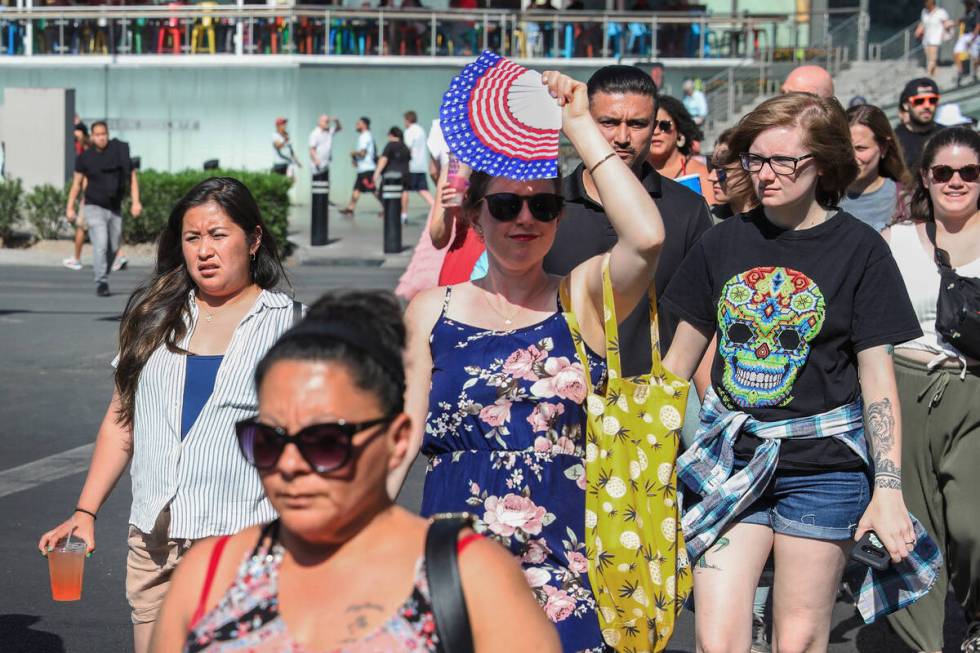Heat warning issued for Las Vegas, cooling stations to open

A record-breaking streak of days without a high of 100 degrees is expected to end Friday, followed by a prolonged heat spell that will intensify through the weekend.
Thursday marked 294 consecutive days since temperatures reached 100 degrees, according to National Weather Service Meteorologist Barry Pierce, who said the Las Vegas region broke the record on Monday.
Pierce also said there’s a “pretty good shot” that temperatures will hit triple digits Friday to tie the record set on June 30, 1965, for the latest date in the year to have the first 100-degree day.
An excessive heat warning has been issued for portions of Southern Nevada, northwest Arizona and southeast California from Saturday morning through Monday evening.
In response, Clark County announced that it is opening cooling stations this weekend for those who need respite from the heat.
Las Vegas high temperatures Thursday topped out at 99 degrees.
However, the projected high will be 104 on Friday and reach up to 112 Sunday and Monday before dropping a few degrees into the middle of next week.
Lake Mead is projected to have highs of 113 Sunday and Monday. The Death Valley National Park visitor’s center at Furnace Creek, California, may rise to around 123 on Sunday.
No Las Vegas daily highs are expected to reach records since the highs for June 30 through July 2 are 115 (in 1972), 115 (latest in 2013) and 116 (in 1937).
The Wednesday high at Harry Reid International Airport was 97 degrees, and with Thursday topping out at 99, the valley saw the record 294th consecutive day falling short of 100.
Q: What exactly do the different HeatRisk categories mean and what precautions can I take to minimize my risk of heat related impacts?
A: The graphics below outline the different HeatRisk categories & provide actions you can take to stay safe! #NVwx #AZwx #CAwx https://t.co/BJct9MaJVv pic.twitter.com/Z9VjgrNQmG
— NWS Las Vegas (@NWSVegas) June 28, 2023
The National Weather Service is advising people to be prepared for the extreme heat conditions.
Graphics showing the risks from minor to extreme heat were tweeted Wednesday by the weather service. Each level gives advice for ways to protect yourself.
“Extreme heat will significantly increase the potential for heat-related illnesses, particularly for those working or participating in outdoor activities,” the advisory stated.
Warm overnight temperatures in the mid-80s are not expected to provide much relief to the extreme daytime heat.
Stations open Saturday
Clark County announced Thursday that it is opening daytime cooling stations from Saturday through Monday at these locations:
— Libraries in the Las Vegas-Clark County Library District.
— Walnut Recreation Center, 3075 E. Walnut Road.
— Pearson Community Center, 1625 W. Carey Ave.
— Hollywood Recreation Center, 1650 S. Hollywood Blvd.
— Cambridge Recreation Center, 3930 Cambridge St.
— Whitney Recreation Center, 5712 E. Missouri Ave.
— Courtyard Homeless Resource Center, 314 Foremaster Lane.
— Downtown Recreation Center, 50 E. Van Wagenen Road, Henderson.
— Downtown Senior Center, 27 E. Texas Ave., Henderson.
— Alexander Libary, 1755 W. Alexander Road, North Las Vegas.
— American Legion, Richard Springston Post 60, 1510 Bruce Woodbury Drive, Laughlin.
— Colorado River Food Bank, 240 Civic Drive, Laughlin.
Sun, heat protection cautions
People are likely to flock to the Spring Mountains for cooler temperatures. Proper hydration and sunscreen protection are even more important at high altitude.
According to the Cleveland Clinic, “high altitude” is 8,000 to 12,000 feet above sea level. This means you’re in high-altitude territory, whether hanging out on the deck of Lee Canyon’s Hillside Lodge, playing games in the base area, or taking a hike in Kyle or Lee canyons.
Dehydration decreases the body’s ability to acclimatize to high altitudes, so people must hydrate before and during a visit. It’s also helpful to skip alcohol the night before a high-altitude hike to help with hydration.
For every 1,000 feet of elevation gained, the ultraviolet rays are 8 percent to 10 percent stronger, according to the New York University School of Medicine. That means you should apply sunscreen with a higher SPF before and during a visit to the Spring Mountains. For example, if a person uses SPF 30 in the valley, they should consider sunscreen with a higher SPF, such as 50-70. Also, wearing a sunhat helps shield your face.
As temperatures soar above 100 degrees, weather and Lake Mead officials were asking people to ensure they drink plenty of water and avoid strenuous activity and prolonged exposure to the sun. Knowing the signs of heat exhaustion and heat stroke and watching out for each other are essential.
Contact Marvin Clemons at mclemons@reviewjournal.com. Follow @Marv_in_Vegas on Twitter.